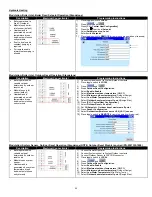
26
PART 4 WATER CONNECTION
Check all applicable local heating, plumbing and building safety codes before proceeding.
If the appliance is installed above radiation level, it must be provided with a low water cut-off device at the time of appliance
installation (available from factory). Some local codes require the installation of a low water cut off on all systems.
A pressure relief valve is supplied with each Advantus. The relief valve must be mounted in a vertical position and
piped to the floor in a manner acceptable to the enforcing authority.
Minimum water operating system pressure should not drop below 30 PSIG. A minimum water pressure relief valve
setting of 50 PSIG is recommended.
Be sure to provide unions and gate valves at inlet and outlet to the appliance so that it can be easily isolated for service. The
provision of a flow setter valve at the appliance outlet will facilitate setting of the proper flow at the desired temperature rise at
high fire.
Special attention to minimum water flow rates will ensure that temperature rise is not excessive. See Table 8.
To eliminate trapped air, install venting devices at high points in the system as well as in the piping on the suction of the pump
and in the piping on the discharge of the appliance.
Use suitable pipe hangers or floor stands to support the weight of all water and gas piping.
Always pump toward the heat exchanger inlet. Never pump away from the exchanger since this will result in a low-pressure
zone, which will allow localized boiling and result in heat exchanger damage.
The
Advantus
must be installed so that the gas ignition system components are protected from water (dripping, spraying, rain,
etc.) during appliance operation and service (circulator replacement, control replacement, etc.)
Figure 17: Typical Space Heating System
4.1
FREEZE PROTECTION
Appliance installations are not recommended outdoors in areas where danger of freezing exists unless precautions are taken.
Maintaining a mixture of 50% water and 50% propylene glycol is the preferred method of freeze protection in hydronic systems.
This mixture will protect the appliance to approximately -35ºF (-37ºC). To maintain the same temperature rise across the
appliance increase the GPM flow by 15% and the head loss by 20%.
The following example demonstrates the procedure to follow for calculating the revised head for the heat exchanger when using a
water/glycol mixture.
Given that Camus is showing a heat exchanger flow and head loss of 100 gpm @ 10 feet
Increasing the flow by 15% now results in a head loss of 13 feet at 115 gpm (from B&G system syzer). At this increased flow
Camus now recommends to increase the head loss by 20%.
The requirement for the heat exchanger with water / glycol mixture will now be 115 gpm @ 15.6 feet. (ie. 1.2 x 13 ft. = 15.6 ft.)
A similar procedure must be followed to calculate the additional head loss in pipe and fittings in order to arrive at the proper
pump selection.
Содержание ADVANTUS AVH 500
Страница 2: ......
Страница 3: ......
Страница 38: ...31 Figure 23 Recommended Piping with Reverse Return and Variable Primary Flow...
Страница 70: ...63 Figure 44 Typical Gas Train Models AV1000 3000 Figure 45 Typical Gas Train Models AV3500 4000...
Страница 88: ...81 PART 12 EXPLODED VIEW Figure A...
Страница 89: ...82 Figure B FAN BURNER ASSEMBLY AV500 600 some items may not be as shown...
Страница 90: ...83 Figure C FAN BURNER ASSEMBLY AV800 4000 some items may not be as shown...
Страница 91: ...84 Figure D Figure E...
Страница 92: ...85 Figure F Figure G...
Страница 93: ...86 Figure H CONTROL BOARD ASSEMBLY...
Страница 100: ...93 PART 13 ELECTRICAL DIAGRAMS...
Страница 101: ...94...
Страница 102: ...95...
















































